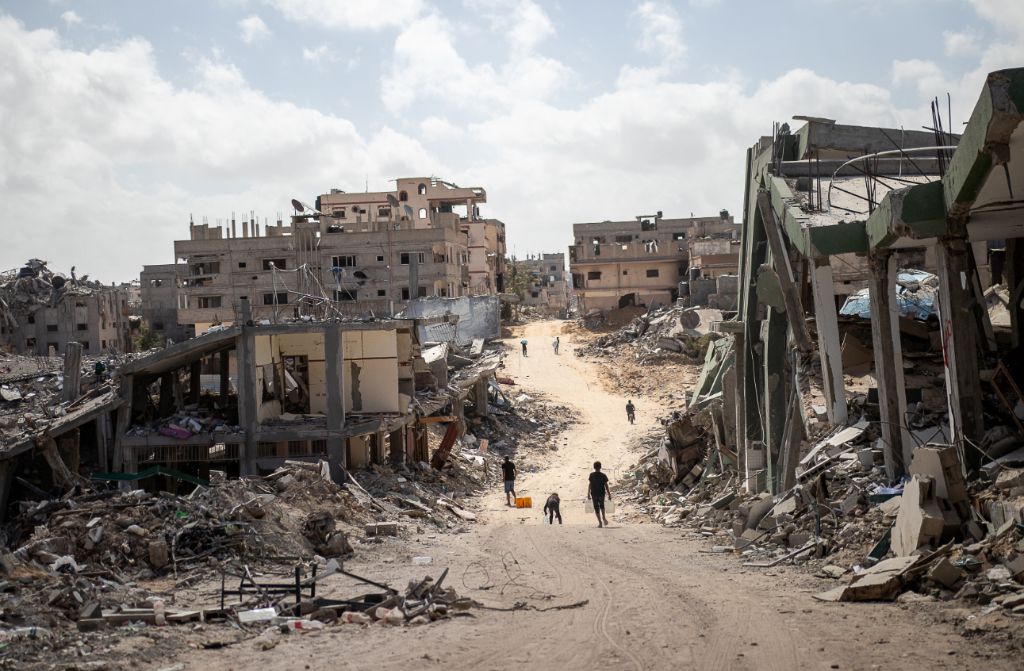GAZA: Aid Workers Find Ghost Town And Children Living Amid Rubble In Khan Younis
Children are living amid rubble in streets of total devastation in Khan Younis, the second largest city in Gaza, according to Save the Children staff returning to the city for the first time since the war started over six months ago.
Prior to the 7 October attacks and war in Gaza, the city in the southern part of the Gaza Strip had a population of more than 200,000 people, including about 100,000 children.
Now Khan Younis is a ghost town, with people returning in small numbers to protect what remains of their properties or retrieve belongings while lone children roam the streets seeking water and other supplies. Media have recently reported that satellite pictures show rows of tents on a site to the west of Khan Younis.
Sacha Myers, a Save the Children spokesperson, has been an aid worker for more than 14 years, and has worked in dozens of disasters including the aftermath of Cyclone Idai in Mozambique and the re-taking of Mosul in Iraq.

Sacha travelled with Karyn Beattie, Save the Children Team Leader in Gaza to Khan Younis this month to assess the damage, road access to key areas, and check on the number of people returning.
Sacha described the scenes as apocalyptic:
"I actually felt physically sick - my body’s reaction to seeing this absolute brutality, for this total disregard for human life.
"I’ve been to a lot of warzones and disasters, but I’ve never been in a situation where as far as the eye can see, every building is rubble. In some conflicts, you will see devastation, but there are gaps between damage and buildings still standing. Here - you turn 360 degrees - every single building is either severely damaged or rubble on the ground. And not just one or two streets, but dozens of streets. It’s everywhere.
"I was also struck by the numbers of lone children. You are driving through what feels like a n empty street and then suddenly you see children climbing out of the rubble. I saw so many children carrying containers, I guess of water - I don’t know for how far they were carrying them - all by themselves, through these destroyed streets. You could see the containers were heavy and hard for the little kids to manage. It was eerie and terrible to see so many children by themselves, knowing how dangerous it is to be in those collapsed and semi collapsed buildings."
Karyn Beattie, Save the Children’s Team Leader in Gaza, said of the mission:
"We are all completely in shock at the level of destruction.
"We are all just so angry at what has happened and the extent of the damage. How is it possible to raze a city like this? And seeing the schools totally destroyed - with the coloured murals on the sides -and knowing that children have been killed in them. How can you not be angry?
"These buildings are the life blood of a society. They are the foundations that make a community and a country and speak to its future. The money and time it will take to rebuild... if the bombs stop falling... will be crippling. A generation of children, if they survive, will have nowhere to learn from and nowhere to go."
Recent attempts by families to return to their homes in Khan Younis and further north in Gaza speak to the dire conditions faced by families across the Strip. These were areas hardest hit by airstrikes, where aid is most restricted and basic services non-existent. Parties to the conflict have legal obligations to protect civilians, wherever they are in Gaza.
Save the Children is assessing the feasibility of establishing a primary health care clinic in Deir Al Balah in central Gaza and the coastal zones, preparing for any potential movement of people further north in the future.
Despite the significant challenges, Save the Children remains operational in northern Gaza through a local partner which is running recreational activities with children across 13 shelters and has conducted an awareness-raising campaign about protective measures for unaccompanied and separated children.


 UN News: 10,000 People Feared Buried Under The Rubble In Gaza
UN News: 10,000 People Feared Buried Under The Rubble In Gaza Save The Children: Heat-stricken Bangladesh Extends School Closures
Save The Children: Heat-stricken Bangladesh Extends School Closures Hayden Stephens and Associates: Record Class Action Settlement Gives Hope To 50,000 Australian Junior Doctors
Hayden Stephens and Associates: Record Class Action Settlement Gives Hope To 50,000 Australian Junior Doctors UN News: Healing Page By Page In Earthquake-affected Türkiye
UN News: Healing Page By Page In Earthquake-affected Türkiye Save The Children: Rate Of Attacks On Healthcare in Gaza Higher Than In Any Other Conflict Since 2018
Save The Children: Rate Of Attacks On Healthcare in Gaza Higher Than In Any Other Conflict Since 2018 UN News: Green Light For New Cholera Vaccine, Ukraine Attacks Condemned, Action Against Racism
UN News: Green Light For New Cholera Vaccine, Ukraine Attacks Condemned, Action Against Racism